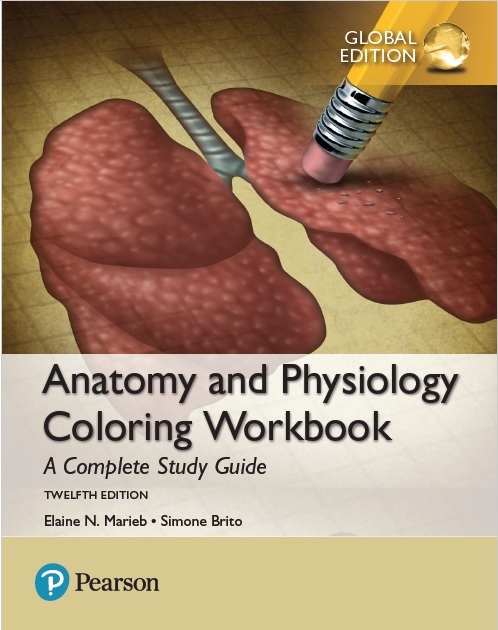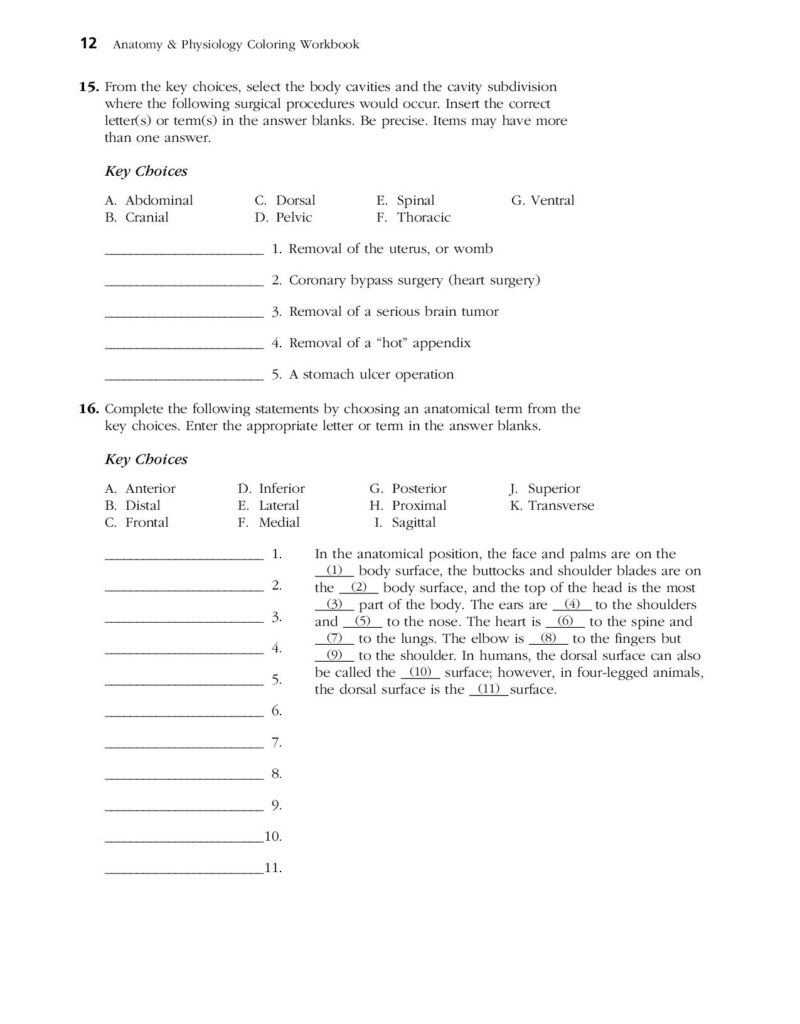Ever found yourself staring blankly at a page of anatomical diagrams, wishing you could somehow etch those structures onto your brain? You’re not alone. The human body is a complex and fascinating machine, but it can feel like a confusing labyrinth of bones, muscles, and organs when you’re first learning about it. But what if there was a way to learn, remember, and even visualize the intricate workings of the human body in a fun and engaging way? Enter the realm of anatomy and physiology coloring workbooks: a vibrant and surprisingly effective tool for mastering the building blocks of human health.

Image: usmlebooksdownload.com
Anatomy and physiology coloring workbooks are specifically designed to bridge the gap between visual learning and conceptual understanding. By coloring detailed anatomical diagrams, you’re not just passively absorbing information; you’re actively engaging with the structures, their relationships, and their functions. This hands-on approach taps into a deep-seated human instinct – the desire to create and color. It turns a potentially intimidating subject into an enjoyable activity, unlocking a deeper and more lasting understanding of the human body.
Why Coloring?
The power of coloring goes beyond mere aesthetic appeal. It’s a powerful tool for learning and memory retention, a fact backed by scientific research. Here’s why coloring can be a game-changer for your anatomy and physiology journey:
- Engaging Active Learning: Coloring moves you beyond passive reading and passive observation. The act of filling in the diagrams with colors forces you to analyze and focus on specific structures, their locations, and their interconnectedness.
- Enhanced Memory and Recall: The motor skills involved in coloring stimulate different parts of the brain, creating a multi-sensory learning experience. This can lead to better retention of anatomical terminology, locations, and functions.
- Increased Focus and Concentration: Coloring can be a mindful activity, requiring you to concentrate and pay attention to detail. This can be especially beneficial when studying complex anatomical concepts.
- Stress Reduction and Relaxation: The act of coloring can be soothing and relaxing, reducing stress and anxiety associated with learning new subjects. This calmer state of mind can improve your ability to absorb and process information.
Choosing the Right Workbook
The world of anatomy and physiology coloring workbooks is diverse, offering a range of options to cater to different learning styles and needs. Here are some key factors to consider when choosing a workbook that’s right for you:
1. Level of Detail and Complexity
Coloring workbooks come in various levels of complexity, from introductory guides designed for beginners to comprehensive resources catering to advanced learners. Choose one that aligns with your current knowledge base and learning goals. If you’re just starting, a beginner-friendly workbook with simplified diagrams and clear explanations is a good starting point.

Image: printablesworksheets.net
2. Content Coverage
Consider the scope of the workbook and whether it covers the specific anatomical and physiological systems you need to study. Some workbooks focus on specific systems like the skeletal system, muscular system, or nervous system, while others offer a comprehensive overview of the entire body.
3. Layout and Design
The layout and design of the workbook can significantly impact your learning experience. Look for clear diagrams, well-organized content, and engaging visuals that make the information accessible and enjoyable to learn.
4. Additional Features
Some coloring workbooks go beyond simple diagrams, offering additional features like quizzes, review sections, and answer keys. These features can be helpful for reinforcing your understanding and assessing your progress.
How to Make the Most of Your Coloring Workbook
With the right workbook in hand, you’re ready to unlock the potential of color-powered learning. Here are some tips to enhance your experience and maximize your learning outcomes:
1. Get Organized
Create a dedicated study space with ample light, a comfortable seating arrangement, and necessary supplies like pencils, crayons, markers, and an eraser. This organized environment can set the stage for focused and productive coloring sessions.
2. Start with the Basics
Begin with simpler diagrams and gradually progress to more complex ones. This gradual approach helps build your understanding and confidence, allowing you to tackle increasingly challenging anatomy and physiology concepts.
3. Use Color Strategically
Think about the colors you choose. Use different shades for different tissues, organs, and structures to enhance visual distinction and improve memory retention. For instance, you can assign specific colors to bones, muscles, nerves, and blood vessels.
4. Label and Annotate
Don’t just color; annotate! Label the structures, systems, and functions as you color. This active learning strategy reinforces the information and allows you to create a personalized, annotated atlas of the human body.
5. Incorporate Other Learning Methods
Coloring is a valuable tool, but it should be part of a well-rounded study approach. Combine coloring with reading textbooks, watching educational videos, attending lectures, and participating in practical activities. This multi-faceted approach ensures that you’re learning from various perspectives and building a deeper understanding of the subject matter.
6. Don’t Be Afraid to Experiment
Embrace creativity! Coloring doesn’t have to be rigid. Experiment with different coloring techniques, shading, and blending to bring the diagrams to life. This playful exploration can make learning more enjoyable and memorable.
7. Share Your Work
Share your colored diagrams with classmates, friends, or family. This act of sharing not only fosters a sense of community but also necessitates further understanding and articulating the anatomy and physiology concepts you’ve learned.
Beyond the Textbook: Real-World Applications
The knowledge gained from an anatomy and physiology coloring workbook transcends the classroom. It has real-world applications that can benefit you in multiple aspects of life:
- Health and Wellness:** Understanding the basics of anatomy and physiology empowers you to make informed decisions about your health, lifestyle choices, and medical treatments. You can learn about the interconnectedness of different systems, the impact of lifestyle choices on your body, and the potential risks and benefits of various medical interventions.
- Career Paths:** A solid foundation in anatomy and physiology is essential for numerous careers, including healthcare professionals like doctors, nurses, physical therapists, and athletic trainers. It can also be beneficial for careers in fields like research, fitness, sports performance, and nutrition.
- Everyday Life:** Knowledge of anatomy and physiology can enhance your understanding of everyday experiences. From understanding why certain exercises work, to recognizing the signs and symptoms of illness, to appreciating the remarkable resilience of the human body, this knowledge enriches your perspective on the world around you.
Anatomy And Physiology Coloring Workbook: A Complete Study Guide
Conclusion
The journey of uncovering the mysteries of the human body begins with a spark of interest. Anatomy and physiology coloring workbooks provide that spark, transforming the potentially daunting task of learning into an engaging and interactive experience. By tapping into the power of coloring, you can unlock a deeper understanding of the human body, enhance your memory, and build a firm foundation for your future endeavors. So, grab your coloring tools and embark on this colorful exploration of the intricate and fascinating world of anatomy and physiology.





